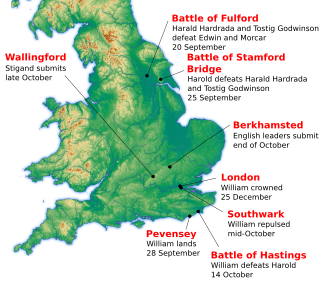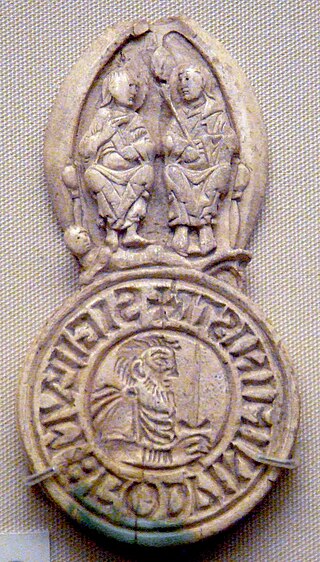Related Research Articles

Alfred the Great was King of the West Saxons from 871 to 886, and King of the Anglo-Saxons from 886 until his death in 899. He was the youngest son of King Æthelwulf and his first wife Osburh, who both died when Alfred was young. Three of Alfred's brothers, Æthelbald, Æthelberht and Æthelred, reigned in turn before him. Under Alfred's rule, considerable administrative and military reforms were introduced, prompting lasting change in England.

The Anglo-Saxons were a cultural group that inhabited much of what is now England in the Early Middle Ages, and spoke Old English. They traced their origins to settlers who came to Britain from mainland Europe in the 5th century. Although the details are not clear, their cultural identity developed out of the interaction of incoming groups of Germanic peoples, with the pre-existing Romano-British culture. Over time, most of the people of what is now southern and eastern England came to identify as Anglo-Saxon, and speak the Old English. Danish and Norman invasions later changed the situation significantly, but their language and political structures are the direct predecessors of the medieval Kingdom of England, and the medieval English language. Although the modern English language owes somewhat less than 26% of its words to Old English, this includes the vast majority of words used in everyday speech.

Offa was King of Mercia, a kingdom of Anglo-Saxon England, from 757 until his death. The son of Thingfrith and a descendant of Eowa, Offa came to the throne after a period of civil war following the assassination of Æthelbald. Offa defeated the other claimant, Beornred. In the early years of Offa's reign, it is likely that he consolidated his control of Midland peoples such as the Hwicce and the Magonsæte. Taking advantage of instability in the kingdom of Kent to establish himself as overlord, Offa also controlled Sussex by 771, though his authority did not remain unchallenged in either territory. In the 780s he extended Mercian Supremacy over most of southern England, allying with Beorhtric of Wessex, who married Offa's daughter Eadburh, and regained complete control of the southeast. He also became the overlord of East Anglia and had King Æthelberht II of East Anglia beheaded in 794, perhaps for rebelling against him.

The Norman Conquest was the 11th-century invasion and occupation of England by an army made up of thousands of Norman, Breton, Flemish, and French troops—all led by the Duke of Normandy, later styled William the Conqueror.
A fyrd was a type of early Anglo-Saxon army that was mobilised from freemen or paid men to defend their Shire's lords estate, or from selected representatives to join a royal expedition. Service in the fyrd was usually of short duration and participants were expected to provide their own arms and provisions. The composition of the fyrd evolved over the years, particularly as a reaction to raids and invasions by the Vikings. The system of defence and conscription was reorganised during the reign of Alfred the Great, who set up 33 fortified towns in his kingdom of Wessex. The amount of taxation required to maintain each town was laid down in a document known as the Burghal Hidage. Each lord had his individual holding of land assessed in hides. Based on his land holding, he had to contribute men and arms to maintain and defend the burhs. Non-compliance with this requirement could lead to severe penalties.

In Anglo-Saxon England a thegn was an aristocrat who owned substantial land in one or more counties. He ranked at the third level in lay society, below the king and ealdormen.

Wulfstan was Bishop of Worcester from 1062 to 1095. He was the last surviving pre-Conquest bishop. Wulfstan is a saint in the Western Christian churches.

A housecarl was a non-servile manservant or household bodyguard in medieval Northern Europe.

Ætheling was an Old English term (æþeling) used in Anglo-Saxon England to designate princes of the royal dynasty who were eligible for the kingship.
The hide was an English unit of land measurement originally intended to represent the amount of land sufficient to support a household. It was traditionally taken to be 120 acres , but was in fact a measure of value and tax assessment, including obligations for food-rent, maintenance and repair of bridges and fortifications, manpower for the army, and (eventually) the geld land tax. The hide's method of calculation is now obscure: different properties with the same hidage could vary greatly in extent even in the same county. Following the Norman Conquest of England, the hidage assessments were recorded in the Domesday Book of 1086, and there was a tendency for land producing £1 of income per year to be assessed at 1 hide. The Norman kings continued to use the unit for their tax assessments until the end of the 12th century.

A burh or burg was an Anglo-Saxon fortification or fortified settlement. In the 9th century, raids and invasions by Vikings prompted Alfred the Great to develop a network of burhs and roads to use against such attackers. Some were new constructions; others were situated at the site of Iron Age hillforts or Roman forts and employed materials from the original fortifications. As at Lundenburh, many were also situated on rivers: this facilitated internal lines of supply while aiming to restrict access to the interior of the kingdom for attackers in shallow-draught vessels such as longships.

Bookland was a type of land tenure under Anglo-Saxon law and referred to land that was vested by a charter. Land held without a charter was known as folkland.

Anglo-Saxon charters are documents from the early medieval period in England which typically made a grant of land or recorded a privilege. The earliest surviving charters were drawn up in the 670s: the oldest surviving charters granted land to the Church, but from the eighth century, surviving charters were increasingly used to grant land to lay people.

The Burghal Hidage is an Anglo-Saxon document providing a list of over thirty fortified places (burhs), the majority being in the ancient Kingdom of Wessex, and the taxes assigned for their maintenance. The document, so named by Frederic William Maitland in 1897, survives in two versions of medieval and early modern date. Version A, Cotton Otho B.xi was badly damaged in a fire at Ashburnham House in 1731 but the body of the text survives in a transcript made by the antiquary Laurence Nowell in 1562. Version B survives as a composite part of seven further manuscripts, usually given the title De numero hydarum Anglie in Britannia. There are several discrepancies in the lists recorded in the two versions of the document: Version A includes references to Burpham, Wareham and Bridport but omits Shaftesbury and Barnstaple which are listed in Version B. Version B also names Worcester and Warwick in an appended list.
Morcar was a thane (minister) of King Æthelred the Unready. He was given lands in Derbyshire in 1009, including Weston-on-Trent, Crich, and Smalley by King Æthelred in 1011 and 1012. He was also given the freedom from the three common burdens. He and his brother were executed in 1015. Morcar's brother's wife was later married to King Edmund Ironside.
A chancery or chancellery is a medieval writing office, responsible for the production of official documents. The title of chancellor, for the head of the office, came to be held by important ministers in a number of states, and remains the title of the heads of government in modern Germany and Austria. Chancery hand is a term for various types of handwriting associated with chanceries.

Taxation in medieval England was the system of raising money for royal and governmental expenses. During the Anglo-Saxon period, the main forms of taxation were land taxes, although custom duties and fees to mint coins were also imposed. The most important tax of the late Anglo-Saxon period was the geld, a land tax first regularly collected in 1012 to pay for mercenaries. After the Norman Conquest of England in 1066, the geld continued to be collected until 1162, but it was eventually replaced with taxes on personal property and income.
Infangthief and outfangthief were privileges granted to feudal lords under Anglo-Saxon law by the kings of England. They permitted their bearers to execute summary justice on thieves within the borders of their own manors or fiefs.

Feudal duties were the set of reciprocal financial, military and legal obligations among the warrior nobility in a feudal system. These duties developed in both Europe and Japan with the decentralisation of empire and due to lack of monetary liquidity, as groups of warriors took over the social, political, judicial, and economic spheres of the territory they controlled. While many feudal duties were based upon control of a parcel of land and its productive resources, even landless knights owed feudal duties such as direct military service in their lord's behest. Feudal duties were not uniform over time or across political boundaries, and in their later development also included duties from and to the peasant population, such as abergement.

The hermeneutic style is a style of Latin in the later Roman and early Medieval periods characterised by the extensive use of unusual and arcane words, especially derived from Greek. The style is first found in the work of Apuleius in the second century, and then in several late Roman writers. In the early medieval period, some leading Continental scholars were exponents, including Johannes Scotus Eriugena and Odo of Cluny.
References
- ↑ Souter, Alexander (1968). Oxford Latin Dictionary. Oxford University Press. ISBN 0-198-64224-5.
- ↑ Lapidge, Michael; John Blair; Simon Keynes; Donald Scragg (15 November 2000). The Blackwell Encyclopaedia of Anglo-Saxon England. Wiley-Blackwell. pp. 456–457. ISBN 0-631-22492-0.
- ↑ Stenton, Frank M. (20 September 2001). Anglo-Saxon England: Reissue with a new cover (3 ed.). Oxford University Press, USA. p. 289. ISBN 0-19-280139-2.
- 1 2 Hollister, C. Warren (1962). Anglo-Saxon Military Institutions on the Eve of the Norman Conquest. Oxford University Press. p. 60.
- 1 2 Stevenson, W.H. (October 1914). "Trinoda Necessitas". The English Historical Review. 29 (66).
- ↑ Chisholm, Hugh, ed. (1911). . Encyclopædia Britannica . Vol. 27 (11th ed.). Cambridge University Press. pp. 286–287.